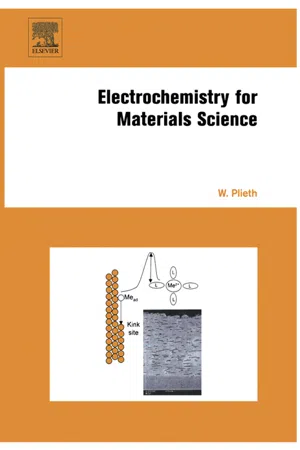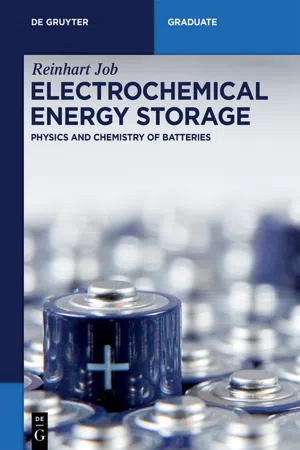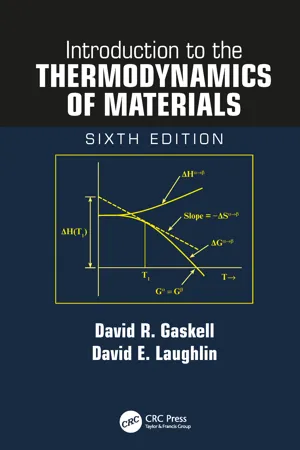Chemistry
Electrode Potential
Electrode potential refers to the measure of the tendency of an electrode to gain or lose electrons when it is in contact with an electrolyte. It is a key concept in electrochemistry and is used to understand and predict the direction of electron flow in chemical reactions. The electrode potential is measured in volts and is essential for determining the feasibility of redox reactions.
Written by Perlego with AI-assistance
Related key terms
Related key terms
1 of 4
Related key terms
1 of 3
11 Key excerpts on "Electrode Potential"
- eBook - ePub
Introductory Bioelectronics
For Engineers and Physical Scientists
- Ronald R. Pethig, Stewart Smith(Authors)
- 2012(Publication Date)
- Wiley(Publisher)
electrochemical potential of each chemical species is the same in every phase . This is an important concept for understanding the functioning of a reference electrode, such as the silver-silver chloride or calomel electrode, for example.A good example of a practical electrochemical cell (or more precisely a combination of two half-cells) is shown in Figure 5.10 in the form of the Daniell Cell. This cell consists of a zinc electrode immersed into a zinc sulphate solution as one half-cell, together with a copper electrode immersed in a copper sulphate solution. These two half-cells are ionically connected via a glass tube containing a gel saturated with a potassium chloride solution. This so-called ‘salt bridge’ prevents charge building up in each half-cell during the electron transfer eeactions at each electrode. A porous ceramic can be used for this purpose instead of the salt bridge. Although the frit will produce small junction potentials, it is experimentally more convenient than preparing a conventional salt bridge. The Gibbs free energy (chemical potential) of the system is related to the emf E (1.1 V) of this cell by:Figure 5.10 The Daniell Cell. The electrochemistry of this cell is discussed in detail in Example 5.1.(5.2)where n is the number of electrons transferred (n = 2 in this case). From Equations (5.1) and (5.2) the Electrode Potential is given as:(5.3)The factor (−ΔG o /nF) in Equation (5.2) is termed the standard reduction potential E o .5.3.4 Standard Reduction Potential and the Standard Hydrogen Electrode
The reduction potential (also known as the redox potential or oxidation-reduction potential ) is a measure of the tendency of a chemical species to acquire electrons and hence to be reduced. The reduction potential is measured in Volts. Each chemical species has its own intrinsic reduction potential. The more positive the potential, the greater is the species' affinity for electrons, and the greater its tendency to be reduced. Reduction potentials of chemicals in aqueous solutions are determined by measuring the potential difference between an inert sensing electrode (e.g. platinum, gold, graphite) in contact with the solution and a stable reference electrode connected to the solution by a salt bridge. The inert metal acts as a source or sink of electrons but takes no further part in the redox reaction. So far in this chapter we have considered the case of electrodes immersed in a solution (e.g. Figures 5.9 and 5.10 ). It is also possible to establish an equilibrium potential at a gas-metal electrode. The gas is passed over the surface of the electrode, which is immersed in a solution of ions related to the gas. If chlorine is the gas then the solution must contain chloride ions. Hydrogen can also be used as the gas, and so the solution should contain H+ ions (protons). The Standard Hydrogen Electrode (SHE) is the reference from which all standard reduction potentials are determined (see Figure 5.11 - eBook - ePub
- Walfried Plieth(Author)
- 2008(Publication Date)
- Elsevier Science(Publisher)
3Electrode Potentials
Publisher Summary
In this chapter, the Nernst potential of a metal using the concentration dependence of the chemical potential of an electrolyte is derived. To measure the potential, the half-cell is connected to a suitable second half-cell. For example, a copper electrode (Cu metal in CuSO4 ) can be coupled with a zinc electrode (Zn metal in ZnSO4 ). A diffusion potential E dif usually occurs then at the interface of the two electrolytes. If both half-cells contain sulfuric acid of a concentration much larger than the copper sulfate concentration, the diffusion potential can be neglected. For unknown activities the measurement of the standard Electrode Potential is more complicated. The standard Electrode Potential is defined at 1 mol/kg with the hypothetical activity coefficient of 1 (ideal diluted solution). First principal experimental determinations of standard potentials may only be made by extrapolation to this hypothetical value. For measurements, selected cell arrangements are used with complete elimination of the diffusion potential and with diluted electrolytes. Any cell reaction can be considered to be an electron transfer between two coupled half-cells. The measured potential corresponds to the difference of the electron energy. The arbitrary definition of a reference electrode raises the question of whether the electrochemical potential scale can be correlated with energy scales of electrons in surface physics. If measuring work functions or electron affinities, the reference value is the free electron in a vacuum.If a metal is immersed in an electrolyte the equilibrium of the metal atoms and the hydrated metal ions in an aqueous electrolyte is described by the equation3.1 PURE METALS
3.1.1 Equilibrium between a metal phase and an electrolyte phase
(3.1)Me⋅ nz +H 2O +ze −↔ Me + nH 2O(3.1)According to the jellium model the metal can be considered as metal ions embedded in the electron plasma. The thermodynamic condition for electronic equilibrium between both phases is, from a chemist’s point of view, equal values of the electrochemical potentialsμ ˜e - eBook - ePub
Biosensors
Microelectrochemical Devices
- M Lambrechts, W Sansen(Authors)
- 2021(Publication Date)
- CRC Press(Publisher)
anode :Ecell = Ecathode - Eanode . (2.9)Equation (2.8) is not practical in experimental electrochemistry, as the activity of the electroactive species is usually not known. Equation (2.8) can be converted into concentrations if, instead of the standard Electrode Potential E0 , the formal potential E0' is introduced (Bard and Faulkner 1980). This quantity is a measured potential and it incorporates the standard potential and several activity coefficients. The Nernst relation can then be written in a more practical form.E =E+0 ′lnR Tn F. (2.10)[ O] a[ R] bThe quantities between brackets now represent the bulk concentrations. The formal potential however varies from medium to medium and is dependent of the ionic strength of the electrolyte. This equation is the basis of the analytical technique known as potentiometry. As can be seen in formula (2.10), the potential varies according to the logarithm of the concentration. 2.1.1.3 Kinetics of the electrode reactions. In the theory of electrode kinetics, the current through an electrochemical cell is studied as a function of the potential. In 1905 Tafel derived an experimental law that stipulated that the current is usually related exponentially to the overpotential η. Tafel formulated his law asη = a + b log i. (2.11)This relation is sometimes written in an exponential form asi = a'eη/b' . (2.12)A successful model of electrode kinetics must be compatible with the Tafel equation and the Nernst equation. Such a model was derived by Butler and Volmer. This equation gives a relation between the rate constant and the overpotential. Via the reaction rate this equation can also be related to the cell current. - eBook - ePub
Electrochemical Energy Storage
Physics and Chemistry of Batteries
- Reinhart Job(Author)
- 2020(Publication Date)
- De Gruyter(Publisher)
eq. (3.139 ), we also can use the following expression:(3.140)E=c e l l0E−r e d0Eo x0In this expression E0 red is related to the electrode, where the reduction occurs (i.e., at the cathode); and E0 ox is related to the electrode, where the oxidation occurs (i.e., at the anode). In a galvanic cell, the less noble metal operates as an anode, where oxidation occurs [half-reaction, where metal ions from the anode dissolve into the electrolyte leaving electrons behind in the anode (loss of electrons)]. The nobler electrode is the cathode, where reduction occurs (gain of electrons). Hence, electricity is generated due to the electric potential difference between the two different metal electrodes of each half-cell, and the potential difference results from the difference between the individual potentials of the two metal electrodes with respect to the electrolyte.If the Gibbs free energy is positive (ΔG0 cell > 0), we speak about an electrolytic cell that undergoes a redox reaction, when electrical energy is applied. Such a cell is used for the decomposition of chemical compounds, for instance, the decomposition of water into hydrogen and oxygen. The electrolytic cell also consists of two half-cells. In a galvanic cell, chemical energy is converted into electrical energy, and in an electrolytic cell, electrical energy is converted into chemical energy.The overall potential of a galvanic cell (or an electrochemical cell including electrolytic cells) can be measured. Usually this is done against the SHE. However, there is no simple way to measure the potential between an electrode and the electrolyte, that is, the isolated potential of the half-cell. In this sense, the standard Electrode Potential is the electromotive force that can be measured in a galvanic cell that consists of one half-cell with the electrode under consideration and the other half-cell with the SHE.The SHE was already mentioned in Section 3.2.2. As explained earlier, the standard Electrode Potentials are measured relative to the SHE, and for that matter, the SHE potential is defined as 0 V. For the sake of comparability, such measurements have to be carried out under standard conditions. The standard Electrode Potentials of metals and semimetals are arranged in the galvanic series. - eBook - ePub
Electrochemical Science and Technology
Fundamentals and Applications
- Keith Oldham, Jan Myland, Alan Bond(Authors)
- 2011(Publication Date)
- Wiley(Publisher)
Figure 6-2 . This cell is equipped with a salt bridge (page 66) to eliminate most of the junction potential that would otherwise exist. When the current direction is as shown, the copper working electrode functions as a cathode, but with a less positive applied voltage it could become an anode. Or, on opening the switch, it would soon behave as an equilibrium cell. There are two ways of reporting the potential of this working electrode:Figure 6-2 Schematic diagram of a typical electrochemical cell. The Ag|AgCl|KCl(1000 mM) electrode serves as the reference electrode and a salt bridge links the two half cells.6:8In the second option, the absence of any mention of a reference electrode implies that the measured voltage has been converted to the SHE scale. In such cases, the Electrode Potential expresses what the measured cell voltage would have been had the reference electrode been a standard hydrogen electrode functioning ideally .Notice that the terms “galvanic” or “electrolytic” are no longer useful descriptors of such a cell as that in Figure 6-2 , because such a classification depends on the (arbitrary) choice of a reference electrode.The convention of using a hydrogen-based standard reference electrode can be applied to cells that employ water-like solvents such as methanol CH3 OH and liquid ammonia NH3 , but it is mostly restricted to aqueous systems. In other cases, the upper option in 6:8 is adopted by specifying explicitly what the reference electrode is. When the temperature departs from 25°C, it is wise to report the reference conditions, even when the system is aqueous. One popular and effective reference system for many nonaqueous solvents is the ferrocenium | ferrocene611 couple based on the6:9equilibrium, with both species present at equal small concentrations612 .Standard Electrode Potentials: they are related to standard Gibbs energiesAs described above for aqueous systems, the potential of a working electrode is E = ΔE – E RE , where RE is the reference electrode. Because it equals the value that the cell voltage would have had with an ideal SHE as reference, the supposed cell reaction would have been6:10for the cell diagrammed in Figure 6-2 .Because of polarizations (Chapter 10), it is difficult to interpret the Electrode Potential of a cell through which current is flowing. However, if the switch shown in Figure 6-2 - eBook - ePub
An Introduction to the Physics and Electrochemistry of Semiconductors
Fundamentals and Applications
- Maheshwar Sharon(Author)
- 2016(Publication Date)
- Wiley(Publisher)
Table 5.1 , some of the standard redox potentials are given to illuminate the significance of the values of these potentials. These potentials are measured under standard conditions, such as the concentration of electrolyte being 1 M and temperature being 25 °C.Redox potential of a few systems measured with reference to Pt/H+, pH = 1, H2 1 atm.Table 5.1Reaction Standard potential E0 /VLi+ + e ⇌ Li –3.045 Ti++ + 2e ⇌ Ti –1.63 Zn++ + 2e ⇌ Zn –0.76 Cr3+ + e ⇌ Cr2+ –0.42 0.00AgCl + e ⇌ Ag + Cl– 0.22 0.268 Cu2+ + 2e ⇌ Cu 0.34 Fe3+ + e ⇌ Fe2+ 0.77 It will be seen from this table that there are few electrolytes whose potentials are negative to the hydrogen potential and few whose potentials are positive to hydrogen potential. It is a convention to arrange all negative potentials above the hydrogen scale with numerical values gradually increasing upward and those with positive potential below the hydrogen scale with their numerical values gradually increasing downward.What do these potentials mean to an electrochemist who is interested in studying the photoelectrochemistry of the semiconductor–electrolyte interface? For any reaction to occur spontaneously, we know that free energy for the reaction must be a negative quantity. And free energy of a reaction is related to Equation 5.19 :(5.19)where δG is the change in the free energy for the reaction being considered, n is the number of electrons involved in the reaction, F is the Faraday of electricity required to complete the reaction with 1 gram equivalent weight of the material; and E is the standard potential of the reaction being considered.Equation 5.19 thus suggests that for an electrochemical reaction to occur, its potential must be positive so that the free energy for the reaction becomes negative. This conclusion immediately suggests that all those redox systems lying above the hydrogen scale in Table 5.1 would be spontaneously oxidized rather than being reduced, whereas those redox systems lying below the hydrogen scale would be spontaneously reduced rather than being oxidized. This concept can further be extended by making a general statement that among the redox systems lying below the hydrogen scale, from two redox systems of different potentials, the lower redox potential system can get oxidized spontaneously if mixed with the redox system of the higher redox potential. For example, if ferrous ions (i.e., Fe2+ ) are mixed with cerric ions (i.e., Ce4+ ), the resulting solution will contain only ferric (i.e., Fe3+ ) and cerric (Ce3+ - eBook - ePub
Physical Chemistry
How Chemistry Works
- Kurt W. Kolasinski(Author)
- 2016(Publication Date)
- Wiley(Publisher)
The potential is the work divided by the unit charge. The inner potential is defined by the work required to move a test charge from infinity to the inside of a phase. This is also known as the Galvani potential φ and is the potential that enters into equilibrium electrochemistry. It is to be distinguished from the external potential, also known as the Volta potential, ψ and the surface potential χ, which are all related by (15.49) The Volta potential is defined by the work required to move a test charge from infinity (either in vacuum, an inert gas, or a solution) to a point close to the surface (∼1 μm away). This distance is sufficiently far away that chemical and image force interactions with the interface can be neglected. Volta potentials and Volta potential differences can be measured directly. However, since we cannot deconvolute the chemical work from electrical work in crossing between two different phases, we cannot unambiguously measure φ, χ nor changes in these. We can, nonetheless, measure changes in the differences of φ and χ. To relate the Galvani potential to measurable quantities, we use our definition of the electrochemical potential in terms of the chemical potential μ, the charge z i on the i -th species, and the Faraday constant F, (15.50) The chemical potential is related to the temperature and activity as given in Eq. (13.51). The term z i Fφ is effectively the work required to move one mole of electrons into a phase with a potential φ at its interior. To move charge from phase A to phase B requires the amount of work determined by (15.51) At equilibrium the electrochemical potential is everywhere the same, thus, which requires that (15.52) Whereas the electrochemical potential is everywhere the same at equilibrium, the Galvani potential is not; that is, the Galvani potential difference Δ φ does not in general equal zero unless by coincidence the inner potentials of the two phases happen to be the same. A consequence of Eq - eBook - ePub
- A.P.H. Peters(Author)
- 2010(Publication Date)
- CRC Press(Publisher)
9 Electrochemical Cells Her own mother lived the latter years of her life in the horrible suspicion that electricity was dripping invisibly all over the house. (James Thurber, My Life and Hard Times) In fact, James Thurber’s grandmother was partly right; many of the chemical processes occurring around us involve the movement of charged ions in liquids, as well as of electrons in metals. As examples, many corrosion processes arise when aqueous electrolytes are in contact with iron, steel or copper, and battery-powered appliances are common. Electrochemical cells give valuable thermodynamic information, as well as being useful in their own right. Measurements of cell electromotive force (e.m.f.) yield free energy changes directly, and tabulations of Electrode Potentials provide an alternative source of free energy data. Variations of e.m.f. with concentration lead to a better understanding of activities, and we shall also see how to measure entropy changes from the variation of cell e.m.f. with temperature. 9.1 ELECTROCHEMICAL CELLS A cell is a device for harnessing the energy of a chemical process to do electrical work, directly. A cell e.m.f. is available at the electrodes, which are immersed in, or in contact with, the electrolyte in which charged species, ions, are mobile. If a bar of zinc is dipped into a diluted solution of zinc sulfate, some zinc ions, Zn 2+, dissolve, leaving two electrons each on the metal. This causes a separation of charge, and eventually (Figure 9.1) equilibrium is achieved. An electrical double layer forms, which consists of electrons on the metal surface and zinc ions immediately adjacent to it. At this stage, the tendency to dissolve is exactly matched by the tendency of zinc ions to deposit, which is caused by the charge separation. This means that there is a potential difference between metal and solution, which, however, cannot be measured - eBook - ePub
- David R. Gaskell, David E. Laughlin(Authors)
- 2017(Publication Date)
- CRC Press(Publisher)
Consider the processes which occur when a metal is immersed in an electrolyte. The asymmetric forces at the interface between the metal and the electrolyte cause the rearrangement of the solvent dipoles and the charged species in such a manner that the electrolyte side of the interface becomes electrically charged. The electric field produced operates across the interface, and, depending on the direction of the field, free electrons in the metal either move toward or away from the interface until a charge is induced in the metal which is equal and opposite to that on the electrolyte side of the interface. This separation of charge causes the development of a difference in electric potential between the interface and the bulk of the electrolyte far removed from the interface. Figure 14.3a shows the nature of the variation of electric potential with distance away from the interface into the electrolyte when the metal acquires a negative charge. Figure 14.3b shows the corresponding variation when the metal acquires a positive charge. The difference between the potential at the metal, ϕ M, and the potential in the bulk of the electrolyte, ϕ e, is called the absolute potential of the electrode. In the Daniell cell, before external electrical contact is made between the electrodes, the zinc electrode acquires an excess of electrons, and the copper has a deficit of electrons. This causes the variation of electric potential from the zinc electrode through the electrolyte to the copper electrode to be as shown schematically in Figure 14.4. The equilibrium Figure 14.2 The Daniell cell. Figure 14.3 A schematic representation of the variation, with distance from a metal/electrolyte interface, of the potential when (a) the metal electrode acquires a negative charge, and (b) when the electrode acquires a positive charge. Figure 14.4 A schematic representation of the variation of potential with position in a Daniell cell - eBook - ePub
Thermodynamics
Principles Characterizing Physical and Chemical Processes
- Jurgen M. Honig(Author)
- 2013(Publication Date)
- Academic Press(Publisher)
It is this difference in the electrochemical potentials that drives the spontaneous electron transfer through the external circuit of the cell. A minimalist description of the above spontaneous operational process is then given by Figure 4.4.1 Schematic diagram showing the direction of the emf, electrochemical potential gradient, electrostatic potential gradient, and electric field during spontaneous operation of a cell operating in conformity with Conventions 1 and 2, described below. Zn (s) + Cu 2 + (a r) + SO 4 2 − (a r) + 2 e − (r) = Cu (s) + Zn 2 + (a l) + SO 4 2 − (a l) + 2 e − (l). (4.4.1) Contrary to conventional practice, the electrons are included as part of the overall reaction: the electrochemical. potentials at the two electrodes differ, being (at least partially) counteracted by the opposing voltage of the potentiometer. Therefore, the electron concentrations do not cancel. The solid species are indicated by (s), and the ionic activities in the two compartments, by the activity a. A detailed rationale for writing Eq. (4.4.1) as shown is provided as a footnote. 1 We next invoke the generalized equilibrium condition, ∑ i ν i ζ i = 0 = ∑ i ν i (μ i + z i F ϕ) where z i is the charge on species i ; for uncharged species ζ i = μ i. As before, ζ i and μ i are the electrochemical and chemical potentials of species i in solution, φ is the electrostatic potential acting on the species, and the stoichiometric coefficients for reagents in the chemical reactions as written are negative. The equilibrium condition as applied to the Daniell cell operation. reads 2 μ Zn (s) ∗ + μ CuSO 4 (sol) ∗ + R T ln a ± 2 (r) + 2 F ϕ Cu 2 + (r) − 2 F ϕ SO 4 2 − (r) + 2 F ζ e (r) = μ Cu (s) ∗ + μ ZnSO 4 (sol) ∗ + R T ln a ± 2 (l) + 2[--=PLGO-SEPARAT. OR=--]F ϕ Zn 2 + (l) − 2 F ϕ SO 4 2 − (l) + 2 F ζ e (l). (4.4.2) The subscript e refers to electrons - eBook - ePub
- John Kenkel(Author)
- 2013(Publication Date)
- CRC Press(Publisher)
4+ ]. At the end point, there would be a sharp change in the measured E.Automatic titrators have been invented, which are based on these principles. A sharp change in a measured potential can be used as an electrical signal to activate a solenoid and stop a titration.14.6 Voltammetry and Amperometry
Electroanalytical techniques that measure or monitor the current flow between a pair of electrodes utilize the electrolytic cell concept. Such techniques were first mentioned in Chapter 12 (Section 12.6.5 ) in describing the amperometric detector for HPLC. An electrolytic cell, you will recall from Section 14.1 , operates with a power source in the electrode circuit to force a current to flow through the electrode system. The voltammetric and amperometric techniques usually utilize three electrodes, rather than two. The three electrodes are the working electrode , the auxiliary electrode (sometimes called the counter electrode ), and a reference electrode (such as those described in Section 14.5 ). A special electronic circuit for carefully controlling the power that the system receives utilizes the three-electrode system. The circuit applies a small, carefully controlled electrical polarization (an “applied” potential ) to the working electrode and the resulting current is due to the analyte being either reduced or oxidized at this electrode. This current is proportional to the concentration of the analyte in the solution. Voltammetric methods measure the current that flows as the applied potential is varied. Amperometric methods measure the current that flows as a result of a constant
Index pages curate the most relevant extracts from our library of academic textbooks. They’ve been created using an in-house natural language model (NLM), each adding context and meaning to key research topics.
Explore more topic indexes
Explore more topic indexes
1 of 6
Explore more topic indexes
1 of 4










